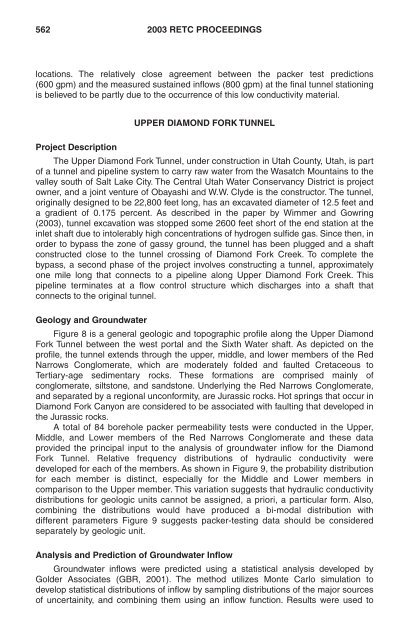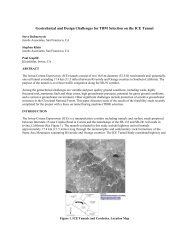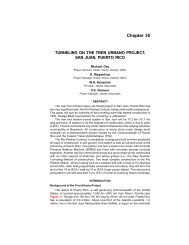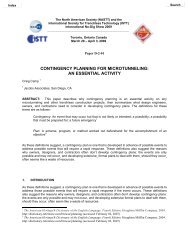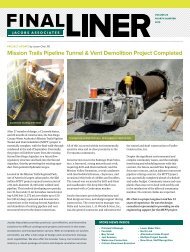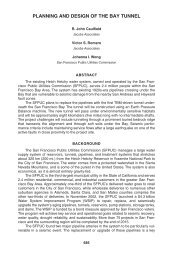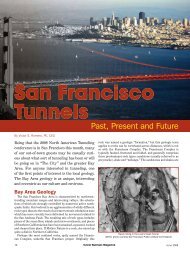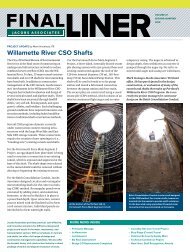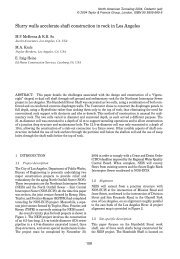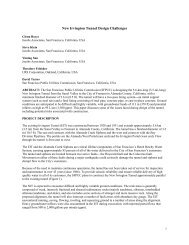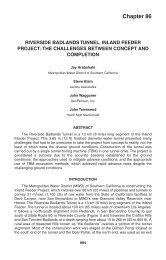Predicted and Observed Groundwater Inflows into Two Rock Tunnels
Predicted and Observed Groundwater Inflows into Two Rock Tunnels
Predicted and Observed Groundwater Inflows into Two Rock Tunnels
Create successful ePaper yourself
Turn your PDF publications into a flip-book with our unique Google optimized e-Paper software.
562 2003 RETC PROCEEDINGS<br />
locations. The relatively close agreement between the packer test predictions<br />
(600 gpm) <strong>and</strong> the measured sustained inflows (800 gpm) at the final tunnel stationing<br />
is believed to be partly due to the occurrence of this low conductivity material.<br />
UPPER DIAMOND FORK TUNNEL<br />
Project Description<br />
The Upper Diamond Fork Tunnel, under construction in Utah County, Utah, is part<br />
of a tunnel <strong>and</strong> pipeline system to carry raw water from the Wasatch Mountains to the<br />
valley south of Salt Lake City. The Central Utah Water Conservancy District is project<br />
owner, <strong>and</strong> a joint venture of Obayashi <strong>and</strong> W.W. Clyde is the constructor. The tunnel,<br />
originally designed to be 22,800 feet long, has an excavated diameter of 12.5 feet <strong>and</strong><br />
a gradient of 0.175 percent. As described in the paper by Wimmer <strong>and</strong> Gowring<br />
(2003), tunnel excavation was stopped some 2600 feet short of the end station at the<br />
inlet shaft due to <strong>into</strong>lerably high concentrations of hydrogen sulfide gas. Since then, in<br />
order to bypass the zone of gassy ground, the tunnel has been plugged <strong>and</strong> a shaft<br />
constructed close to the tunnel crossing of Diamond Fork Creek. To complete the<br />
bypass, a second phase of the project involves constructing a tunnel, approximately<br />
one mile long that connects to a pipeline along Upper Diamond Fork Creek. This<br />
pipeline terminates at a flow control structure which discharges <strong>into</strong> a shaft that<br />
connects to the original tunnel.<br />
Geology <strong>and</strong> <strong>Groundwater</strong><br />
Figure 8 is a general geologic <strong>and</strong> topographic profile along the Upper Diamond<br />
Fork Tunnel between the west portal <strong>and</strong> the Sixth Water shaft. As depicted on the<br />
profile, the tunnel extends through the upper, middle, <strong>and</strong> lower members of the Red<br />
Narrows Conglomerate, which are moderately folded <strong>and</strong> faulted Cretaceous to<br />
Tertiary-age sedimentary rocks. These formations are comprised mainly of<br />
conglomerate, siltstone, <strong>and</strong> s<strong>and</strong>stone. Underlying the Red Narrows Conglomerate,<br />
<strong>and</strong> separated by a regional unconformity, are Jurassic rocks. Hot springs that occur in<br />
Diamond Fork Canyon are considered to be associated with faulting that developed in<br />
the Jurassic rocks.<br />
A total of 84 borehole packer permeability tests were conducted in the Upper,<br />
Middle, <strong>and</strong> Lower members of the Red Narrows Conglomerate <strong>and</strong> these data<br />
provided the principal input to the analysis of groundwater inflow for the Diamond<br />
Fork Tunnel. Relative frequency distributions of hydraulic conductivity were<br />
developed for each of the members. As shown in Figure 9, the probability distribution<br />
for each member is distinct, especially for the Middle <strong>and</strong> Lower members in<br />
comparison to the Upper member. This variation suggests that hydraulic conductivity<br />
distributions for geologic units cannot be assigned, a priori, a particular form. Also,<br />
combining the distributions would have produced a bi-modal distribution with<br />
different parameters Figure 9 suggests packer-testing data should be considered<br />
separately by geologic unit.<br />
Analysis <strong>and</strong> Prediction of <strong>Groundwater</strong> Inflow<br />
<strong>Groundwater</strong> inflows were predicted using a statistical analysis developed by<br />
Golder Associates (GBR, 2001). The method utilizes Monte Carlo simulation to<br />
develop statistical distributions of inflow by sampling distributions of the major sources<br />
of uncertainity, <strong>and</strong> combining them using an inflow function. Results were used to


